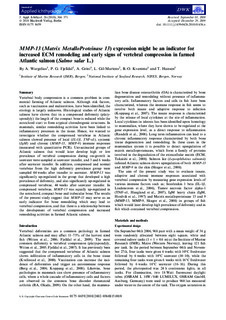| dc.contributor.author | Wargelius, Anna | |
| dc.contributor.author | Fjelldal, Per Gunnar | |
| dc.contributor.author | Grini, Ane | |
| dc.contributor.author | Gil-Martens, L. | |
| dc.contributor.author | Kvamme, Bjørn Olav | |
| dc.contributor.author | Hansen, Tom | |
| dc.date.accessioned | 2010-11-25T14:28:20Z | |
| dc.date.available | 2010-11-25T14:28:20Z | |
| dc.date.issued | 2010-04 | |
| dc.identifier.citation | Journal of Applied Ichthyology, 26 (2), 2010: 366-371 | en_US |
| dc.identifier.issn | 0175–8659 | |
| dc.identifier.issn | 1439-0426 | |
| dc.identifier.uri | http://hdl.handle.net/11250/117041 | |
| dc.description | Journal homepage: http://onlinelibrary.wiley.com/journal/10.1111/(ISSN)1439-0426 | en_US |
| dc.description.abstract | Vertebral body compression is a common problem in commercial farming of Atlantic salmon. Although risk factors, such as vaccination and alnutrition, have been identified, the etiology is largely unknown. Histological studies of Atlantic salmon have shown that in a compressed deformity (platyspondyly) the length of the compact bone is reduced while the notochord start to form atypical chrondrogenic structures. In mammals, similar remodeling activities have been linked to inflammatory processes in the tissue. Hence, we wanted to investigate whether the compressed vertebrae in Atlantic salmon showed presence of local (IL-1β, TNF-α1), systemic (IgM) and chronic (MMP-13, MMP-9) immune responses (measured with quantitative PCR). Unvaccinated groups of Atlantic salmon that would later develop high or low prevalence of vertebral compression during on-growth in seawater were sampled at seawater transfer, and 3 and 6 weeks after seawater transfer. In addition, compressed and normal vertebrae from the high deformity prevalence group were sampled 44 weeks after transfer to seawater. MMP-13 was significantly up-regulated in the group that developed a high prevalence of deformity, and also significantly up-regulated in compressed vertebrae, 44 weeks after seawater transfer. In compressed vertebrae, MMP-13 was equally up-regulated in the notochord, compact bone and trabecular bone. The results of the present study suggest that MMP-13 may serve as an early indicator for bone remodeling which may lead to vertebral compression, and that there is a relationship between the development of vertebral compression and increased remodeling activities in farmed Atlantic salmon. | en_US |
| dc.language.iso | eng | en_US |
| dc.publisher | Blackwell | en_US |
| dc.subject | atlantic salmon | en_US |
| dc.subject | atlantisk laks | en_US |
| dc.subject | nutrition | en_US |
| dc.subject | ernæring | en_US |
| dc.subject | fish physiology | en_US |
| dc.subject | fiskefysiologi | en_US |
| dc.title | MMP-13 (Matrix MetalloProteinase 13) expression might be an indicator for increased ECM remodeling and early signs of vertebral compression in farmed Atlantic salmon (Salmo salar L.) | en_US |
| dc.type | Journal article | en_US |
| dc.type | Peer reviewed | en_US |
| dc.subject.nsi | VDP::Agriculture and fishery disciplines: 900::Fisheries science: 920::Aquaculture: 922 | en_US |
| dc.subject.nsi | VDP::Agriculture and fishery disciplines: 900::Fisheries science: 920::Fish health: 923 | en_US |
| dc.source.pagenumber | 6 s. | en_US |
| dc.identifier.doi | http://dx.doi.org/10.1111/j.1439-0426.2010.01436.x | |
